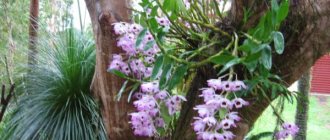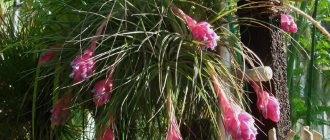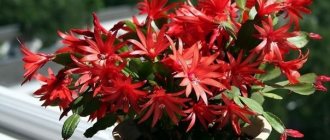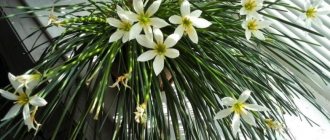- October 27, 2018
- Flowers
- Alexander Nedashkovsky
Orchids for their beauty by any many gardeners. More and more housewives are purchasing them to decorate their home. In our article we want to talk about one of the varieties of orchids - dendrobium. How to care for a beautiful exotic plant so that its flowering will delight us for a long time? Dendrobiums are very numerous in the wild and grow over a large area. But breeders also delight flower growers with their work, presenting new varieties of exotic plants.
Beautiful exotics
There are probably not many gardeners who do not like orchids. Beautiful exotics are increasingly appearing on our windowsills. The description of dendrobiums should begin with the mention that they are the most numerous representatives of the Orchid family. The plant's homeland is considered to be Indonesia, the Himalayas, Japan, China, New Zealand and Vietnam. Dendrobiums belong to epiphytic crops, as they most often grow on trees. However, there are some species that prefer rocks or ground. The very name of the flower in translation means “living on a tree,” which immediately speaks of its habitat.
Dendrobium orchid species
Dendrobium - the most beautiful flower
Among the variety of species and varieties of orchids, it is impossible to single out any special variety that would gain universal popularity. They are all beautiful in their own way.
Dendrobium nobile
Photo: Dendrobium nobile
Dendrobium nobile is native to Vietnam and the Himalayas. Shiny thick pseudobulbs are characterized by rapid growth and reach 0.5 m in length already in the first year of life. In the next season, flower stalks are formed, of which there are from 1 to 3 on one plant. The flowers are large, rich in color, up to 10 cm in diameter.
The natural-looking flowers are pure white, the tips of the petals are tinged with purple, the lip is cream, and the throat is dark purple in color. Hybrids have different colors and bloom several times a year.
Dendrobium phalaenopsis
Dendrobium phalaenopsis
Dendrobium phalaenopsis The orchid got its name due to the identical shape of flowers with phalaenopsis. Naturally distributed in Australia.
Pseudobulbs, together with leathery glossy leaves, reach 0.7 m in length. The species simultaneously forms up to 10 flowers, 8 cm in diameter, which are located on a high peduncle. More often the petals are painted burgundy.
Flowering is long-lasting, up to 2 months. It falls at the end of November - beginning of December. Several peduncles may appear on the same pseudobulb in one season. The best type for novice gardeners.
Dendrobium moniliforme
Dendrobium moniliforme
Dendrobium moniliforme Moniliforme is a noble dendrobium in miniature. The stem of the bush reaches no more than 15 cm in height, the rosette is very beautiful. Inexperienced gardeners should have this species at home, as it is easy to care for, especially since it blooms with beautiful “butterflies”.
Dendrobium parishii
Dendrobium parishii
Dendrobium parishii The hanging shoots of an epiphthous plant reach 0.3 m in length. There are also more powerful specimens.
The pointed oblong-lanceolate leaves grow up to 12 cm in length. Single flowers, painted in an amethyst-purple tone, bloom on the dendrobium. The rounded lip is densely strewn with purple-brown spots, the anther is purple, the column is snow-white. Characterized by summer flowering.
King's Dendrobium (Dendrobium kingianum)
Dendrobium kingianum
King's Dendrobium (Dendrobium kingianum) Native to Australia. The lower part of the cylindrical stems has a noticeable thickening, and at the top of the stem there are wide leaves.
Flowering is abundant, buds are formed in large quantities, in February. At this time, the King's dendrobium produces a long peduncle, on which 5 pink flowers bloom, exuding a pleasant aroma.
Dendrobium densiflorum
Dendrobium densiflorum
Dendrobium densiflorum is found naturally in the Himalayas. Unusual coloring. All flowers have a rich orange color, which even slightly hurts the eye. Flowering is very abundant. Up to 50 flowers can bloom simultaneously on racemose inflorescences 0.3 m long.
You can learn more about representatives of the orchid family from the video below.
Description of Dendrobium
The plants were first discovered by a Swedish botanist at the end of the eighteenth century in the Caribbean. They soon became very popular in Europe due to the unusual shape of the flowers. Olaf Schwartz called the plant the “tree of life,” which characterizes the epiphytic properties of dendrobium. In nature, there are very small representatives of this genus, and huge giants that reach a length of two meters. Dendrobium flower brushes can be straight or curved. The colors of plants are very diverse. You can see beautiful specimens in all shades, from purple to yellow, including red and white. Sometimes there are representatives that combine several shades at once. Each inflorescence can have from 12 to 100 flowers.
All dendrobiums are characterized by the presence of a lip, the color of which differs from the general shade. Hybrid forms are most often used as pets.
Herbaceous plants reach a height of 90 cm. Their stems are represented by cylindrical pseudobulbs. The leaves are arranged alternately on the stems, their length reaches 10 cm. Peduncles grow from the axils. Each of them subsequently blooms up to 4 flowers, the diameter of which is 6-8 cm. The type of inflorescences can be very different.
Description of the plant, external characteristics
It is almost impossible to confuse this species with other orchids due to its original appearance.
Number of leaves on an adult plant
The main difference between dendrobium is the absence of a basal rosette . Its dense and tough (leathery) leaves grow along the stem on both sides. Their shape is elongated or belt-like, size is 7-10 cm. Each shoot grows up to 6-7 leaves.
Mature plant height
Under natural conditions, dendrobium stretches up to 1 meter in height . The domestic orchid of this species is a bush about 60-80 cm .
Diameter and type of flower
Orchid petals are ovoid in shape, while the sepals are stretched in length.
Dendrobium flowers are collected in groups of 3-4 pieces. Their diameter reaches 10 cm (usually 5-8 cm) . The number and size vary depending on the age and variety of the plant. Up to 50-70 flowers bloom simultaneously on the shoot.
Maximum peduncle length
Another distinctive feature of dendrobium is the peduncle, the length of which is no more than 2-5 cm . Therefore, in the photo, and even on the plant itself, during abundant flowering they are practically invisible.
Lighting
What conditions must be provided for one of the varieties of orchids - dendrobium? How to care for a plant so that it not only takes root in the apartment, but also pleases you with flowering? All varieties of beautiful exotic plants, although they have much in common, do not always require the same care. When purchasing a new flower, immediately determine the living conditions of a particular species.
Any description of dendrobiums in the literature begins with a mention that the plant belongs to the light-loving forms. This is worth remembering when choosing a place for your pet. Dendrobium is a flower that feels great on the south side. But on western or eastern windows the plant will need additional lighting. As for northern window sills, they are absolutely not suitable for tropical inhabitants.
Dendrobium is an indoor flower that requires care. As long as the air temperature outside has not dropped below +7 degrees, the plant can be taken out for ventilation. But it is very important to protect it from direct sunlight. The plant must be gradually accustomed to bright sunlight. Immediately after purchasing an orchid, it must be given time to adapt to new conditions.
If you are just learning the basics of care at home, the dendrobium flower itself will tell you what it needs. The amount of light can be judged by the color of the plant’s foliage. If your pet's greens are dark and rich, this indicates insufficient lighting. But a light green shade indicates an excess of sunlight. Yellowing of the sheets indicates a disastrous lack of lighting.
Growing Dendrobium
Rational care at home is the key to the longevity and health of a flower, so you need to know what it likes and what it may not like.
Lighting and location
Dendrobium is light-loving, but direct sunlight is harmful to it . Therefore, when choosing a location, preference is given to windows facing east or west.
If there is no choice, and all the windows face south, then the orchid will need a “protective screen” in the form of light curtains or blinds. But a flower placed on the north side will need additional lighting. The optimal day length for this plant is at least 12 hours daily .
Dendrobium needs sunlight most of all during the active development of new shoots. As a rule, this is the last ten days of August and the autumn months.
Temperature
The most comfortable temperature regime for dendrobium nobile and most other varieties is 22-28°C in summer and 15-20° in winter . But the plant can quite easily tolerate warming up to 32°C (only with sufficient humidity).
During flowering, for a more active process, the orchid requires an average daily temperature difference of 5-10°C . This can be achieved, for example, with good evening ventilation of the room. Turning off the heating, spraying the plant, or wet cleaning nearby surfaces will also help change the temperature.
Watering
The frequency with which your dendrobium needs to be watered depends on its environment.
In spring and autumn, for example, it is enough to do this every 10-15 days. In summer - 2-3 times a week. And in winter there is no need to water the plant at all . The procedure is resumed only after young flower shoots appear.
The substrate will help you navigate this issue.
Its drying out will “tell” that the flower needs moisture. Advice! The degree of water heating should be 2-3 degrees above room temperature. You can take filtered, well-settled or boiled.
Humidity
Dendrobium is native to the tropics, so the orchid requires high humidity . Its minimum indicator in the room where the flower grows should be 40-50%. The optimal moisture content in the ambient air is 50-80%.
Priming
The simplest option is to purchase a special substrate. But if you wish, you can prepare the soil yourself.
Pieces of old pine bark measuring from 1 to 3 cm are used as a base. The following is mixed with it:
- charcoal (not very large);
- fern roots (if available);
- fellema (you can use natural bottle caps);
- coconut fiber.
If the orchid is on the south side, it is recommended to add a little sphagnum moss to the substrate, which will retain moisture . For flowers growing on northern windows, it is permissible to add small pieces of polystyrene foam to the soil. A moderate amount of peat is also a good addition.
Transplantation rules and pot selection
Dendrobium does not require spacious containers - it will be quite comfortable in a pot where the distance between the walls and roots is only 2-2.5 cm.
Having bought a new flower, you should replant it only next spring . Further “expansion of the living space” of the orchid occurs after 3-4 years.
You should hurry only in certain cases, for example:
- If the substrate has completely turned into dust and can no longer serve as a support for the flower.
- When the root system has grown greatly and there is no room left for soil in the pot.
- If a brown coating appears on the lower part of the plant, the tips of the roots have begun to rot.
The orchid is replanted after the flowers fall . But if traces of disease or decay appear, you should not wait for the plant to bloom.
The process is performed according to the following algorithm:
- Preparing the pot . Its walls should be high enough so that, in addition to the soil and the plant itself, there is room for a drainage layer 3-4 cm thick. The best option is a clay or plastic container with a sufficient number of holes. In this case, the transparency of the pot does not matter much.
- Laying drainage . It is prepared from fairly large, heavy and sterile stones. Along with them you can put large pieces of pine bark.
Carefully! Expanded clay, which is usually used for these purposes, contains calcium, which salinizes the substrate. Therefore, it is better not to take it.
- Flower transfer . Having taken the plant out of the old pot, its roots are completely cleared of the substrate. All damaged parts are cut off with a sharp knife, and the wounds are treated with activated carbon. After the sections have dried, the flower is placed on a drainage layer and a substrate is added without covering the young shoots.
There should be at least 2-3 cm from the soil to the edge of the pot . There is no need to compact the soil when replanting an orchid; just shake the pot slightly so that it is evenly distributed and fills the voids.
After the procedure, the flower is placed away from bright light for 3 weeks . But all this time it is necessary to maintain the ambient temperature within 20°C. The plant should not be watered for the first three days after transplantation.
Top dressing
From the substrate used, dendrobiums cannot obtain the required amount of substances necessary for growth and development. Therefore, the flowers are regularly fed. For this purpose, exclusively liquid fertilizers are used.
Feeding can be root and external. The first is done by adding fertilizer to a pan of water. The second - when spraying plants with a spray bottle.
In both cases, special mineral supplements for orchids are used, but diluted in different concentrations.
So, when root feeding, the dosage of the drug is reduced by 2 times compared to that specified by the manufacturer, and when spraying - by 5 times. During the growing season (April - September), dendrobium is fed twice a month.
Attention! Nitrogen fertilizers promote shoot growth but reduce the likelihood of flowering. Therefore, they should be replaced with phosphorus ones after the children are half grown.
Temperature
Continuing the conversation about how to care for a dendrobium flower, it is worth paying attention to the temperature regime, which plays an important role in the proper development of the plant. During active growth, the optimal temperature for orchids is +25 degrees; at night, the indicator should not fall below +20 degrees.
Many gardeners know that temperatures above +30 degrees are often very destructive for crops. In the summer, many faced a similar problem.
The growth period of orchids usually ends in autumn. At this time, the difference between day and night temperatures can be more than 10 degrees. The optimal temperature is: during the day - +15-20 degrees, and at night - +5-10 degrees.
Humidity
What home care is required for dendrobium? The flower needs a certain level of humidity. It is very difficult to give general characteristics for different species, since they all have different habitats in natural conditions. Some species love warmth and moisture, while others favor drier conditions. But it is possible to determine general indicators of care. It is believed that for dendrobiums the optimal humidity level should be in the range of 50-80%. In the summer, it is quite difficult to provide such conditions. Therefore, experienced gardeners recommend taking plants out onto the balcony in warm weather and spraying them regularly. In winter, it is enough to keep a tray with wet gravel on the windowsill, on which the flowerpot is placed. You can also use artificial humidifiers.
Interesting varieties
The most extensive genus among orchids. Includes about 2000 species, many artificial hybrid varieties. The following varieties and varieties are recommended for growing dendrobium orchids at home.
- King's Dendrobium. Miniature, beautifully flowering variety. The stems are rigid, cylindrical, thickening at the base. Leaves of three or four are concentrated at the top. The flowers are small, but very fragrant. The inflorescence is a raceme of few flowers. Colors vary from white to deep purple.
- Dendrobium Lindley. The stem is a low pseudobulb of oblong-round shape. One leaf is formed on each pseudobulb. Peduncles are long, drooping. The flowers are golden and very fragrant.
- Dendrobium nobile. Large, very common variety. The stems are fleshy, covered with leathery elongated leaves. The sheets are arranged in two rows. Biennial shoots produce small flower stalks. Two or three flowers bloom on each of them. The colors are multicolored - the edges of the petals are pink or lilac, at the base they are delicately creamy. A purple spot stands out on the white, pubescent lip. It is considered an unpretentious species.
- Dendrobium phalaenopsis. Another tall variety with tall, strong stems. Long lanceolate leaves are concentrated at the top. Peduncles are more than half a meter in length. With good care, up to 40 buds can form on one flower arrow. Large flowers are painted white, pink, rich red or crimson. They last a long time when cut.
Common Hybrids
In addition to the main varieties, hybrid varieties deserve attention. They are distinguished by improved characteristics - endurance, long flowering, interesting colors.
- Dendrobium Berry Oda. A hybrid variety of Dendrobium King. One of the most famous hybrids. The color varies from white with a pinkish tint to dark crimson. It begins to bloom at the end of winter and ends only at the beginning of summer. Very easy to care for and grow, easily adapts to apartment conditions.
- Dendrobium Sa-nuk. The hybrid was bred by Thai breeders. It grows quickly, blooms consistently and abundantly. The flowers are small, delicate yellow.
- Dendrobium Hibiki. It is characterized by slow growth, but very beautiful and long-lasting flowering. The flowers are two-tone - pink petals combined with a bright orange lip.
- Dendrobium Stardust. The stems are thin, tall pseudobulbs, divided into segments. They grow densely, hanging slightly to the sides. The length of the pseudobulbs depends on the light intensity. In the shade they stretch out, in bright light they grow shorter and thicker. Leaves are lanceolate-shaped. Each leaf lives up to three years. During flowering, flower stalks appear from the internodes. Each of them bears from one to five flowers. The color varies from light yellow to orange with a reddish tint. The lip is covered with darker veins.
- Dendrobium moniliforme. A hybrid variety of Dendrobium nobile. Miniature plants about 20 cm high. Blooms with small white or soft lilac flowers.
It is necessary to take into account the characteristics of a particular variety. Each hybrid has its own character - some need more sun, others need moisture. You can’t act at random with orchids—you need a serious, thoughtful approach.
Watering during the growth period
Watering is one of the most important stages of care. The dendrobium flower at home must be properly moistened. The first watering after the dormant period should be carried out only after the first signs of vegetative growth appear or when the flower bud ripens.
What is the frequency of water procedures? Water the plant only after the substrate has lightly dried. If the dendrobium grows in the bark, then in the summer it is watered almost every day. To do this, use water purified by a reverse osmosis filtration system and heated to +22-24 degrees. In general, the liquid should be a couple of degrees warmer than the air temperature.
Watering should be done in the morning, and moisture should not get on the foliage, as this increases the risk of fungal diseases. Once a week, gardeners recommend giving a flower a shower. The dendrobium orchid needs to not only wash the foliage, but also the substrate, washing away excess salts from it. Washing the soil is very beneficial for the plant.
Watering the plant is carried out in two ways. You can generously moisten the soil with a watering can or lower the flowerpot with dendrobium into a container of water for 5-10 minutes.
High-quality watering is important for any home flower. Dendrobiums are very sensitive to moisture. How well a plant is watered can be judged by certain signs:
- A flower needs moisture if its roots have a silvery tint.
- After a good watering, the root sheath takes on a glossy green color.
- The next water treatment is given to the plant only after the roots become silver again. Their color is the main indicator of the need for watering.
Table: diseases and pests characteristic of Dendrobium nobile
The best prevention of Dendrobium Nobile against diseases and pests is proper care.
| Diseases and pests | Symptoms | Treatment measures | Prevention |
| Root and stem rot is a fungal disease caused by frequent waterlogging of the soil. | The plant looks drooping. Leaves and pseudobulbs become covered with weeping brown spots. | The plant needs urgent replanting. Remove old substrate. Trim damaged areas of roots and leaves. Sprinkle the wounds and healthy roots with crushed coal and dry. If the damage has severely affected the orchid, the plant must be treated with the biofungicide Mikosan. Plant in new soil mixture. Don't water for a couple of weeks. | Adjust your watering schedule based on the conditions in which the orchid grows. Water only after the soil is completely dry. |
| Thrips | Small winged insects located on the underside of leaves. Damaged leaves turn brown and fall off. The edges of the flower petals look dried out. | Spray the orchid with a solution of Aktara insecticide (4 g per 5 liters of water). If the plant is heavily infected, the treatment should be repeated after 2 weeks. You can use Actellik (2 ml per 2 l) of water. For minor damage, 1 spray is enough; for severe damage, repeat after 15 days. The drug is toxic; personal protective equipment must be used. Drugs can be alternated. | The leaves are cleaned from insects with a napkin soaked in a soap solution, which has an antiseptic and disinfectant effect. Regularly bathe the orchid in the shower. Spraying the plant with garlic tincture. |
| Aphid | Aphids can colonize a flower very quickly. Entire colonies of pests actively suck out cell sap, which is why the orchid's leaves become deformed, turn yellow and die. | ||
| Shchitovka | Sap-feeding insects hide under brown shells. A weakened plant's leaves turn yellow and dry out. | ||
| Spider mite | Leaves and shoots covered with cobwebs are the main sign of the pest. By piercing a leaf, it leaves many small spots, which then merge into large ones. Affected leaves and flower stalks die. |
Photo gallery: recognize pests and diseases
Root rot occurs from frequent waterlogging of the substrate
Leaf of an orchid affected by thrips
At home, aphids often infest the orchid.
Scale insect on an orchid leaf
Spider mites entwine young shoots with the finest cobwebs
Care during the rest period
The onset of a dormant period is a mandatory phenomenon for a dendrobium flower. How to care for him during this time? For most plant varieties, the dormant period comes after the first or second summer growth. The dormant period of dendrobium is pronounced. Since in the middle zone in autumn and winter illumination is significantly reduced, a decrease in the level of living activity is simultaneously observed. The plant seems to freeze. In deciduous forms, leaf fall is even observed. This phenomenon is not typical for plants growing in their natural environment. At rest, all roots are silver in color. But some tips are still colored green. This indicates that the plant continues to grow little by little. During the dormant period, the roots do not need moisture, so there is no need to water the dendrobium. It is enough to moisten the bark with a spray bottle once a week.
Table: the most common care errors and their elimination
| Error | How it manifests itself | Elimination |
| Dry brown spots on leaves | Sunburn | After spraying, do not expose the leaves to direct sunlight (especially through window glass). You need to gradually accustom your orchid to the sun |
| Weeping, rotting spots on leaves | Spraying at low temperatures | Avoid spraying if the air temperature is below 20°C. In such conditions, moisture evaporates very slowly, and conditions favorable for the development of gray rot are created. |
| The lower leaves turn yellow and fall off, but the orchid looks healthy | The natural aging process of sheet plates | Don't worry: the leaf lives no more than 2 years |
| The base of the leaf rots | Water entering leaf axils | After spraying and showering, remove water from the leaf axils with a napkin. |
| Dendrobium refuses to bloom | Not enough light. The rest period was not observed | Dendrobium Nobile is the most light-loving orchid. Without sufficient lighting and a period of rest, the plant will not bloom. |
Soil selection
To transplant dendrobium, you need to take a substrate consisting of bark. Sometimes sphagnum moss is added to it. Moss is especially necessary for keeping orchids in apartments with dry air, since it allows you to retain moisture in the pot. The bottom of the container is usually filled with some gravel for balance or foam for drainage. Next, the pot is filled with a layer of large bark, and then medium and fine. Foam chips make the substrate more breathable. The top roots of the plant can be covered with moss. Of course, for planting it is better to purchase ready-made bark from a specialized store.
Transfer
Watch the flower. As soon as the pot becomes too small for him, it’s time to replant . It is recommended to update the substrate every 2 years.
For young Dendrobiums, choose light-colored plastic pots. They don't get that hot. A couple of pebbles are placed on the bottom to weigh it down. Next is drainage made of polystyrene foam and large bark . The roots are carefully laid on top.
This video shows how to replant a dendrobium orchid after it has finished blooming.
The area around them is filled with soil without compaction. But there shouldn’t be any voids left. Water only on the 7th or 10th day after transplantation. The container is taken a little larger than the rhizomes. For large specimens, clay pots without glaze are suitable.
Preparing for transplant
Inexperienced flower growers who encounter orchids for the first time believe that replanting is an obligatory part of care. Dendrobium flowers should not be replanted unless absolutely necessary. Orchids generally do not like such manipulations. Flowering healthy plants do not need to be replanted. As a rule, orchids are replanted once every three to four years if the substrate has lost its qualities or has become caked. Experts note that it is necessary to disturb the plant as little as possible.
Therefore, transplantation is a last resort. If you need it, then you should know how to do it correctly. Transplantation is carried out after the flowering period.
Before starting the procedure, you need to find the right pot. Most often, transparent flowerpots are chosen, as for other orchids. They are very comfortable. In addition, the Dendrobium nobile flower can be planted in a clay pot, which will provide stability. The dimensions of the container must correspond to the dimensions of the root system. The roots should fit into the pot easily, and there should be a small margin on the sides.
To replant the plant, you need to purchase a suitable size container, soil and fungicide.
Appearance of the flower
Dendrobiums are most often low epiphytic bushes. The huge number of species suggests their significant differences from each other. The height of the plant can be from a few cm for miniature varieties to a meter or more for giants. At home, low specimens are usually grown, no higher than 90 cm.
The aerial roots of Dendrobium, like those of most epiphytic plants, are covered with spongy, multi-layered, hygroscopic dead tissue called velamen. The root system performs many vital functions for an orchid, such as anchoring the plant in the planting substrate, absorbing and storing moisture and nutrients.
Dendrobiums are sympodial orchids. This means that adult plants have several stems with leaves and flowers at once. The stems of these orchids are pseudobulbs, i.e. reserve and store moisture and nutrients just in case. At the base of the pseudobulb, a bud awakens, from which a new shoot begins to grow upward, which is then covered with leaves and flowers, and roots begin to grow downward.
Orchid shoots are smooth, sometimes ribbed, sometimes cylindrical. Almost all of them are thickened and surrounded by membranous tissue. The lifespan of one shoot does not exceed three to four years. After this it dies. This fact can be attributed to the disadvantages of the species. If you have one flower and you really like it, you will have to take care of its propagation in a timely manner.
The leaves, as a rule, are green, located either only at the top of the shoot, or alternately along its entire length. The oblong leaves are also different in shape - ovoid, narrow-lanceolate or elliptical. Sometimes the leaves are similar in density to those of succulents.
Dendrobium flowers also have a variety of shapes, sizes and colors. On one peduncle there are from one to four flowers with a diameter of 4 to 10 cm. The peduncles are located almost in the axil of each leaf. The flowers are painted in various shades of white, yellow, orange, lilac, their petals come in two and even three colors. The duration of flowering and its time depend on the type and variety of these orchids.
There are a huge number of species and hybrid varieties of Dendrobiums. We do not undertake to determine which of them is the most beautiful, it is simply impossible. Therefore, we will introduce you to the most popular varieties of Dendrobiums, which gardeners successfully grow at home.
How to replant a plant?
How to transplant dendrobium correctly? Describing the process will help you cope with a difficult task.
The orchid must be properly prepared for transplantation. To do this, it is pre-soaked in water for ten minutes. This will make it easy to remove the plant from the container. Next, you will have to remove all the bark that is between the roots without damaging them. To remove rotten and dead areas of the root system, we will need sterile instruments.
You should not choose a pot that is too large for planting. The structure of the soil should be similar to that in which the plant was located up to this point. If you purchase the substrate in the store, then you can safely use it for planting. But the self-prepared bark will have to be sterilized to get rid of pests.
The dendrobium is placed in the center of the pot and the roots are straightened, after which the voids are filled with substrate and the plant is slightly pressed down. Next, the orchid is sent to a humid place with diffused light. On the first day, the transplanted plant is not watered, since the damaged roots should dry out.
Recommendations for cultivation
When arriving in a new environment from a flower shop, the King's dendrobium orchid may seem to its new owner to be a very docile and unpretentious plant. However, failure to comply with basic care rules can lead to irreparable consequences, for example, the inability to re-bloom, and the likelihood of flower death increases sharply. To avoid this, consider the recommendations of professionals and basic instructions.
Orchids grown in greenhouses are regularly fed with various growth stimulants and additional fertilizers to ensure the flower has full access to nutrients and energy components over a long period of time. A flower purchased in a store, given the appropriate conditions and the care of the grower, can turn into a colorful ornamental plant with a long flowering period of up to two months.
Orchids that grow in the tropical forests of Asia are characterized by pronounced seasonal characteristics. The growth cycle consists of a period of increased activity, a flowering period and dormancy. Each time period implies the presence of certain conditions and care.
Spraying plants
Every novice gardener tries to provide proper care for the dendrobium. In the house, a flower sometimes requires air humidification, so experts recommend spraying the plant with a spray bottle in the summer. However, not everyone views this positively. Some gardeners believe that this method is not effective and leads to contamination of the leaf plates. In their opinion, it is much more useful to arrange an intensive watering shower once a month, after which the foliage should be wiped with a napkin to remove excess moisture.
Dendrobiums after flowering
After flowering, the plants gradually stop watering, the peduncle is removed, and the flower itself is transferred to a cooler place. Dendrobium needs time to rest to gain strength. In our climate, plants sometimes go into a dormant state due to insufficient lighting.
This behavior is not natural for dendrobium in natural conditions. Of course, there is nothing wrong with this, but some gardeners recommend preventing the plant from falling into a dormant state. To do this, you will have to use a phytolamp to illuminate the plants. If your orchid has fallen asleep, then you should not disturb it. Just stop watering and wait for the first signs of growth.
Features of flowering
Flowering takes place in the last months of winter and spring. To admire the blooms, proper care is necessary at this time.
How to care during flowering?
Photo of an orchid: gorgeous bloom captivates the eye
In order for an adult plant to feel comfortable and produce a peduncle, it is necessary to ensure the correct development cycle, which should include a phase of active growth and rest. If these conditions are neglected, instead of a peduncle, the orchid will delight the owner with young shoots - children that will develop from the pseudobulb.
Thanks to breeding work, you can see different colors of dendrobium flowers. Flowering lasts from 2 weeks to 1.5 months.
In January, you need to reduce watering and move the pot with the plant to the most illuminated place. But the plant can get burned from direct sunlight.
If flower stalks do not want to appear, flowering can be stimulated by applying phosphorus-containing fertilizer.
If this does not help , the dendrobium is given a shower with optimal water at a temperature of +35-40 degrees, no more.
How to care after flowering?
Orchid transplant
Only in some plants the foliage falls and the dendrobium enters a dormant period, preparing for a new flowering.
After flowering, you need to cut off the peduncle if it has changed its color, reduce watering and place it on the windowsill in a cool room. Constantly wet soil will cause the rhizomes to rot.
In its natural environment, dendrobium is always in active growth. Therefore, if the plant has not gone into hibernation, it is recommended to provide additional lighting by installing a phytolamp above it.
Reproduction
There are several ways to propagate dendrobium: by dividing the bush and by children. The first method is very traumatic for the plant. Young plants, taking root in a new place, will not please with flowering for some time.
The second method of reproduction is more preferable. Children are usually formed after flowering. They look like small shoots on the main stem. As soon as the babies reach a length of 5 centimeters, they can be separated from the mother plant with clean tools. With a piece of stem they are planted in prepared soil. To do this you need to take fine bark. And the cut sites on the mother plant are treated with crushed activated carbon. The soil is soaked in water so as not to injure the roots of the children, after which young plants are placed in it.
Sometimes the children on the mother plant independently produce buds that can bloom. In this case, you need to wait until the dendrobium has finished blooming, and only then separate the baby.
At first, young plants need to be provided with a high level of humidity. To do this, you can spray the upper part of the bark daily, without touching the cakes themselves, so that rot does not appear. Young plants are watered so that the substrate is constantly moist, but there is no stagnation of water in it. Water procedures can be carried out from a watering can or by immersing the pot in a container of water.
Within three weeks after the transplant, the children gradually adapt to the new conditions. After this, you can start feeding them with a light solution of complex fertilizer.
Sometimes dendrobium is propagated by cuttings. To do this, the pseudobulb is cut off from the mother bush and cuttings of 10 cm are cut. The cut areas are treated with garden pitch or coal. Next, take ziplock bags and fill them with damp sphagnum moss. You can put two cuttings in each of them. Next, the package is closed and left to be stored at a temperature of +25 degrees and in bright light. The cuttings must be ventilated daily. In about a couple of weeks they will sprout roots. After this, they can be transplanted into pots. The first flowering can only be expected after two to three years.
How to achieve flowering?
Dendrobium is a flower (photos and descriptions are given in the article) quite capricious. It can bloom at any time of the year. But most often the buds appear in the winter-spring period. Flowering duration reaches 8-12 weeks. In elevated temperatures, flower buds can turn into babies.
Sometimes it happens that plants do not please their owners with flowering. Getting buds to appear can be very difficult. Dendrobium requires lower temperatures at night to bloom. In winter, 12-15 degrees is enough for the plant.
Experienced gardeners recommend not watering the dendrobium until growth appears. This simple method will allow you to achieve flowering. As soon as the growth reaches two centimeters, you can begin water procedures again.
Diseases and possible growing problems
Most difficulties are the result of improper growing conditions. The plant weakens, resistance to diseases and pests decreases. The table shows signs for determining maintenance errors or the presence of pests.
Table - Problems that gardeners encounter when growing dendrobium orchids and their possible causes
| Problem | Possible reasons |
| Grayish-brown leaves with a silvery sheen | — Thrips |
| Drying and falling leaves | — Shield; — air humidity below 40%; - long-term lack of watering |
| Shrinkage of pseudobulbs | — A natural phenomenon during the growth of new shoots; - prolonged lack of moisture |
| Active formation of children, lack of flowering | — Failure to comply with the conditions of the rest period; - incorrect watering mode |
| Brown or yellow pseudobulb color | — Root rotting |
| Young shoots grow thin | — Normal phenomenon |
When pests appear, treatment of dendrobium orchids is reduced to treatment with insecticides. If there are few insects, they disappear after the first treatment. In advanced cases, three-time treatment at weekly intervals is indicated. Other problems can be eliminated by adjusting care.
Growing dendrobium may seem difficult only in the first year. Once you understand the essence of care and the needs of the plant, everything will become much simpler. Proper care of your dendrobium orchid guarantees abundant and regular flowering.
Feeding
It is simply impossible to grow any type of orchids without fertilizing. Proper care of dendrobium involves constant application of fertilizers. Orchids are very capricious, so it is necessary to immediately exclude all experiments with fertilizing. You should not prepare all kinds of mixtures yourself. The roots of the plant are very delicate and do not tolerate an excess of substances that can cause burns. It is not always possible to save dendrobium burned with compounds.
For orchids, liquid fertilizers are usually used. The first fertilizing can be done at the time when the plant begins to bloom. In the future, fertilizers are applied every three weeks. Experts recommend combining watering and fertilizing to avoid burns. The concentration of fertilizers should be two times weaker than what is written on the bottle. Tender roots may die from the concentrated composition.
Gardeners recommend feeding heat-loving varieties with phosphorus-potassium preparations once a month even in winter. Fertilization can be continued even in winter. It is believed that fertilizing extends the flowering period and makes it longer.
Cold-resistant species prefer nitrogen-containing substances, thanks to which they increase green mass.











